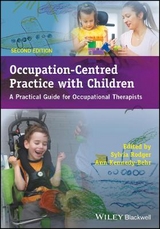
Occupation Centred Practice with Children - a Practical Guide for Occupational Therapists
Wiley-Blackwell (an imprint of John Wiley & Sons Ltd) (Verlag)
978-1-4051-8427-4 (ISBN)
- Titel ist leider vergriffen;
keine Neuauflage - Artikel merken
Sylvia Rodger, Associate Professor and Head of Division, Division of Occupational Therapy, The University of Queensland, Brisbane, AUSTRALIA.
Contributors. Foreward. Preface. Acknowledgements. 1 Introduction to Occupation-centred Practice withChildren (Sylvia Rodger). Introduction. Re-affi rming occupation: the core of occupational therapy. External infl uences impacting occupational therapypractice. The evolution of occupational therapy practice withchildren. Changing views of child development and maturation. Emerging views about occupational development. Refocusing occupational therapy with children Conclusion. References. 2 Becoming more Occupation-centred When Working withChildren(Sylvia Rodger). Introduction. Theoretical underpinnings of occupational therapy withchildren. Top-down and bottom-up approaches to occupational therapypractice with children. Characteristics of occupation-centred practice for children. Conclusion. References. 3 Child- and Family-centred Service Provision (SylviaRodger and Deb Keen). Introduction. Defi ning the client: who and how many? Client-centred practice 46Child-centred practice. Family-centred practice and service provision. Becoming a child- and/or family-centred practitioner. Developing family-centred services. The extended family and community. Conclusion. References. 4 Cultural Influences and Occupation-centred Practice withChildren and Families(Alison Nelson and MichaelIwama). Introduction. Culture and the occupations of the child. The privilege of occupational therapy. Cultural safety in occupational therapy. The Kawa Model: a tool for culturally safe practice. Culturally appropriate goal setting. Making the invisible visible. Relationship: the art of occupational therapy. Conclusion. References. 5 Enabling Children s Spirituality in OccupationalTherapy Practice(Imelda Burgman). Introduction. Spirituality and children. Why does spirituality matter in occupational therapypractice? The art of occupational therapy practice. Children s contexts and spirituality. Conclusion. References. 6 Occupational Goal Setting with Children andFamilies(Nancy Pollock, Cheryl Missiuna, and SylviaRodger). Introduction. Giving children a voice. Goal setting and motivation. Tools to facilitate goal setting with children. Goal setting contributes to outcome measurement. Conclusion. References. 7 Occupation-centred Assessment with Children (TedBrown and Chi-Wen Chien). Introduction. Bottom-up and top-down approaches to assessment. OCAC. Implementation of occupation-centred assessment with children:assessment in action. Occupation-centred assessment with children: tools. Conclusion. References. 8 Cognitive Orientation for Daily Occupational Performance(CO-OP): A Uniquely Occupation-centred. Intervention created for Children(Sylvia Rodger andHelene Polatajko). Introduction. CO-OP: a brief overview. CO-OP: an occupation-centred intervention. Conclusion. References. 9 Perceive, Recall, Plan and Perform (PRPP):Occupation-centred Task Analysis and Intervention System(Christine Chapparo). Introduction. Information processing and occupational performance. The Perceive, Recall, Plan and Perceive (PRPP) System of TaskAnalysis and Intervention. Using the PRPP System of Task Analysis and Intervention:David. Perceive : observing and prompting sensoryprocessing behaviours during task performance. Recall : observing strategies used for storage andretrieval of information during task performance. Plan : processing information for organisingandproblem solving. Perform : processing output and performancefeedback. Conclusion. References. 10 Occupational Performance Coaching: Enabling Parents and Children s Occupational Performance(Fiona Grahamand Sylvia Rodger). Introduction. Theoretical and philosophical basis. Three enabling domains. Structured problem-solving process . Conclusion. References. 11 Occupation-centred Intervention in the SchoolSetting(Elizabeth A. Hinder and Jill Ashburner). Understanding the occupations of the school student. Educationally relevant occupational therapy in schools. Ways of working in schools. Planning educational programmes for diverse learners. Occupation-centred information gathering in educationalsettings. Occupation-centred programme planning and intervention inschools. Collaboration in service delivery. Conclusion. References. 12 Enablement of Children s LeisureParticipation(Anne Poulsen and Jenny Ziviani). Introduction. Outcomes of healthy leisure engagement. EACH-Child: model of leisure coaching. Step one: creating successful engagements. Step two: coaching to promote personal growth. Conclusion. References. 13 Acute Hospitals: A Challenging Context forOccupation-centred Practice with Children(Sylvia Rodger andRebecca Banks). Introduction. Occupation-centred practice in hospital settings: lessons fromthe literature. Occupation-centred practice in hospitals: lessons from thefrontline. Challenges to occupation-centred practice in hospitals. Strategies to foster occupation-centred practice inchildren s hospitals. Examples of occupation-centred practice in children shospital settings. Conclusion. Acknowledgements. References. 14 Enabling Children s Occupations and Participationusing Assistive Technology(Desleigh de Jonge and RachelMcDonald). Introduction. What is assistive technology? What can assistive technology offer children and families? A theoretical model for understanding assistive technology. Information gathering for augmentative and assistivetechnologies. Utilising assistive technology for children as anoccupation-centred intervention. Specifi c assistive technology interventions for children. Evaluating AT outcomes. Conclusion. References. 15 Decision Making for Occupation-centred Practice withChildren(Jodie Copley, Sally Bennett, and MerrillTurpin). Introduction. Decision making and information sources. Information about clients, families and their contexts. Information about the practice context. Information from empirical research. Information from clinical experience. Integrating information despite alternatives anduncertainties. Shared decision making. Conclusion. References. Index.
| Erscheint lt. Verlag | 9.4.2010 |
|---|---|
| Verlagsort | Chichester |
| Sprache | englisch |
| Maße | 170 x 242 mm |
| Gewicht | 1 g |
| Themenwelt | Medizin / Pharmazie ► Medizinische Fachgebiete ► Pädiatrie |
| Medizin / Pharmazie ► Physiotherapie / Ergotherapie ► Ergotherapie | |
| ISBN-10 | 1-4051-8427-2 / 1405184272 |
| ISBN-13 | 978-1-4051-8427-4 / 9781405184274 |
| Zustand | Neuware |
| Haben Sie eine Frage zum Produkt? |
aus dem Bereich



